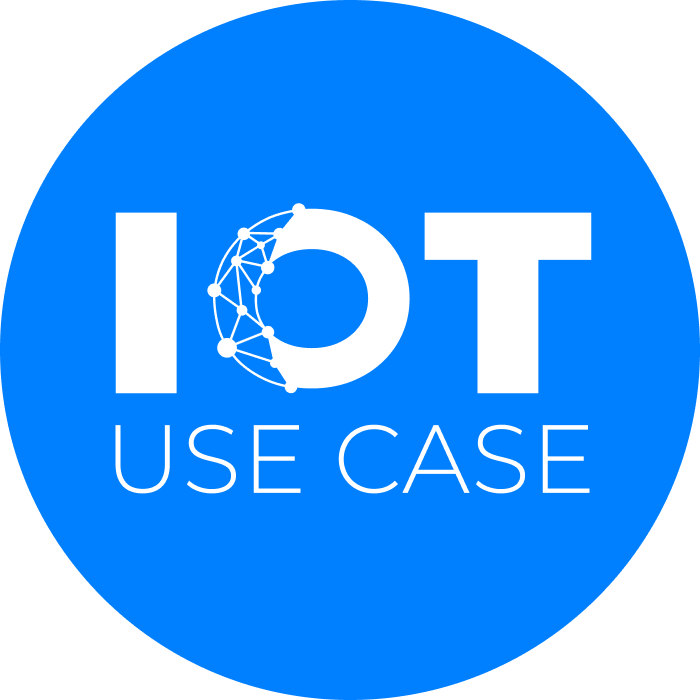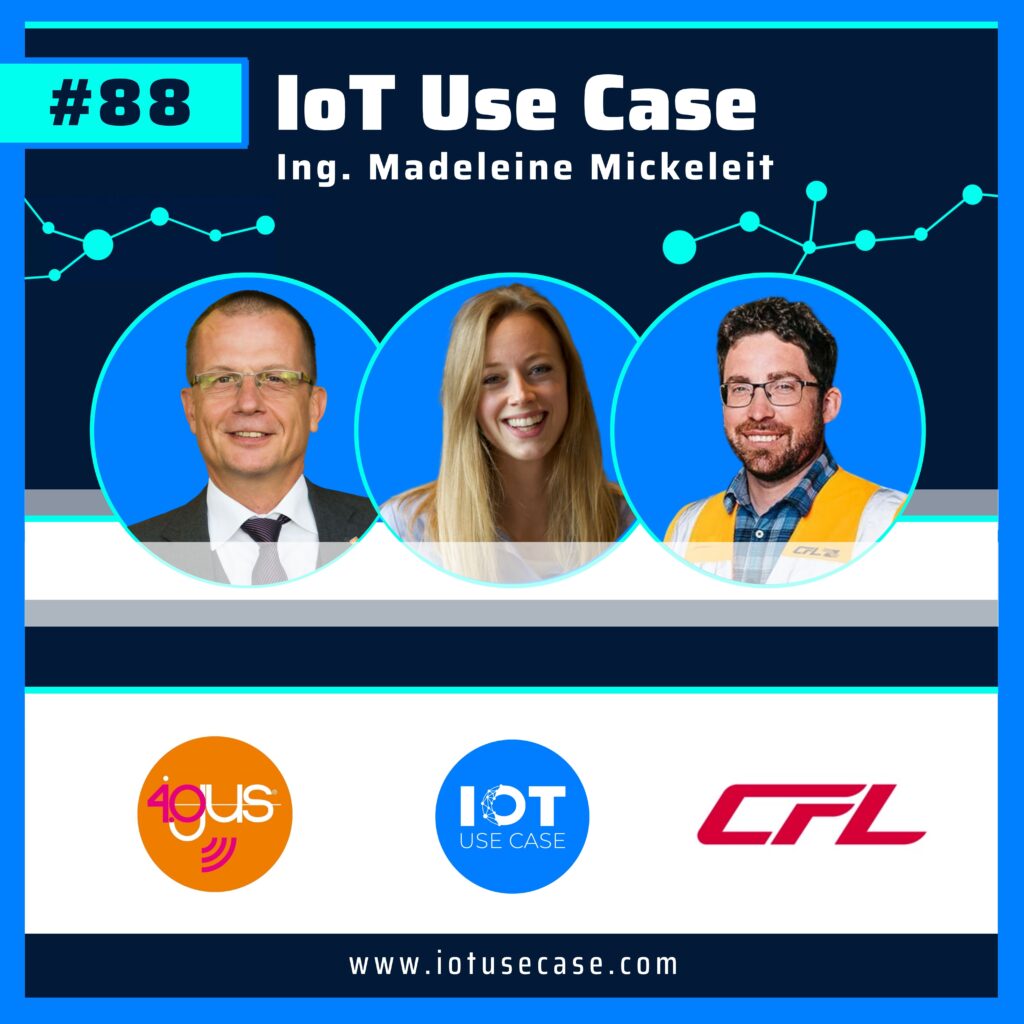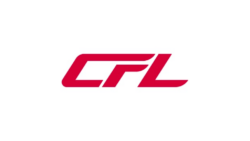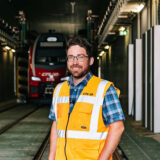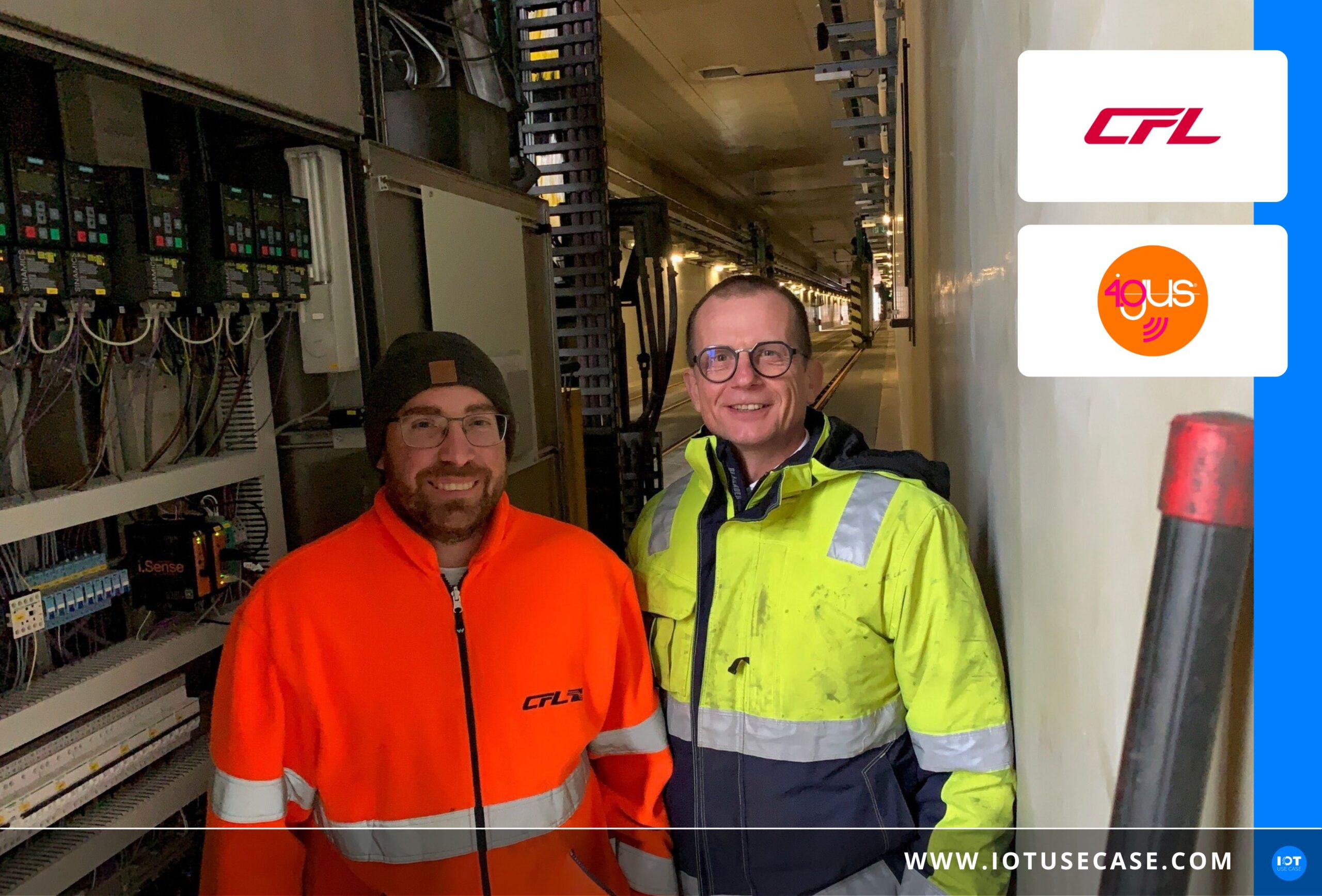This podcast episode is about intelligent sensor technology for condition monitoring and predictive maintenance in train washing stations. The Luxembourg train company CFL has recognized that smooth operation requires an energy chain system that not only works reliably in the here and now, but also plans ahead. The answer was found in the polymer energy chains from igus.
Episode 88 at a glance (and click):
- [15:57] Challenges, potentials and status quo – This is what the use case looks like in practice
- [26:57] Results, Business Models and Best Practices – How Success is Measured
- [33:36] Solutions, offerings and services – A look at the technologies used
Podcast episode summary
The train wash station of Luxembourg’s national railroad company (french abbreviation: CFL) cleans local and long-distance trains daily in its 200-meter-long wash hall. So-called energy chains are used so that the wash trolleys can travel on both sides of a train. These energy chains safely guide all hoses and lines for energy, compressed air, water and cleaning agents back and forth.
Malfunctions and failures of these chains are extremely costly and lead to interruptions in the operating process or even to plant breakdowns. Train runs have to be postponed or cancelled.
In this podcast episode, we talk about how CFL is now applying a solution that overcomes this challenge. Today, energy chains from igus are used together with intelligent sensor technology that monitors the condition of the system and maintains it in a predictive manner.
How exactly are these failures prevented? Which components were to blame for the failure? How and with which tools was the whole project approached? And how are things going at the moment?
Episode 88 of the IoT Use Case Podcast features these answers directly from CFL Maintenance Manager Mike Feinen. He tells how the team initiated a modernization program and implemented it together with their chosen partner igus – represented here by Richard Habering, Head of Business Unit igus® smart plastics.
Smart solutions for condition monitoring and predictive maintenance – extending product runtimes & maintenance costs – a more efficient and environmentally friendly train wash station.
Podcast interview
Hello Richard and Mike! Nice to have you with us today. I’m so glad you’re here and welcome to the IoT Use Case Podcast. Richard, how are you doing right now and where are you currently?
Richard
I’m doing great and for once you can reach me in Cologne, in the factory, in the development office.
That’s a rarity, because otherwise you’re always in the U.S. and elsewhere.
Richard
There is a lot of need for communication and the world would like to learn IoT.
Mike, how are you? Where are you at the moment?
Mike
I am also doing very well. I’m in our meeting room. It’s a little quieter there than in the normal office.
From my words, what you do at igus: You come into play wherever movements in industrial processes are involved. You are manufacturers of energy supply systems from small to large energy chains. I myself have already stood next to a huge chain, they can take on the most varied dimensions.
But you also work on cables, linear technology, bearing technology, plain bearings, ball bearings and much more. These are so-called “low-wear high-performance polymers”; a really exciting area and core business. A Cologne-based company, 188,000 customers from over 80 countries from all over the world and for 50 different industries you offer the whole thing!
Why I find your segment totally exciting is because you’ve been going down the path with “Motion Plastics” for a few years now and are developing smart components, so to speak. You use the data of these components and make the wear limits usable in the form of IoT services, improve the components in terms of condition monitoring or also in terms of predictive maintenance.
Richard, what’s happening in your market that you’ve started to go in that direction with IoT?
Richard
Thanks for the introduction, that was one hundred percent perfect. We make high performance polymers, energy supply chains, cables, plastic plain bearings.
There is another figure that is interesting at this point. On 11/11/2022, we achieved 1 billion in sales of these plastic products. For a Cologne company, 11/11 is very special; great story! We “smart plastics”, a very small team, take care when our plastic products communicate with the customer. For us, it’s not just IoT, not just predictive maintenance, but whenever the plastic product, the line, the chain, and also the warehouse, provides the customer with information about a possible upcoming replacement or something just isn’t working, in other words, possible malfunctions; that’s what we have bundled in the smart plastics department. We do this for the energy supply systems and the cables as well as for the plain bearings.
We work with sensors, for the most part sensors developed in-house, and use them to make predictions about service life in many of the application areas. These, in turn, are all based on the tests and measurements that have been carried out in our laboratory for many years.
In short, we have known for some time how long our products will last, now we have the appropriate sensor technology to go with it, and now we can present the whole thing to our customers. Just as they can no longer buy a car today without an information system – when the car should go to the workshop, when unexpected faults occur – this is a requirement, in our opinion and also according to the feedback we have received from customers over the last four years, that continues into the industrial sector and into the component sector, such as plastic components. We think it’s going to be difficult in the next five years to sell components in industrial applications without those having some kind of connectivity or some kind of communication. That’s in the context of all product development and digitization; everything is becoming interconnected, so you have to make that information available.
Can you give us some insight into which customers you work with specifically in this IoT segment? Are they regular customers or new customers?
Richard
For the most part, these are regular customers. We are trying to offer connectivity with the opportunity in IoT and also to attract new customers. At present, IoT solutions, i.e. solutions connected to the network, are mainly to be found in the port sector, the container logistics sector and in the project business. Large, heavy equipment moved long distances combined with the fact that a failure would produce exceptionally high costs. As I said: the container sector, the crane sector, the logistics sector, projects, bulk handling, but also the automotive industry, i.e. automotive production, where every second of unexpected production downtime causes gigantic costs. That’s where we’re positioned, and that’s where the products are in use, both online and offline.
How did you get to know each other? How did that come about with the two of you or with the two companies?
Mike
We have a large 200-meter long wash-station from the CFL. There are four wash portals included and they have energy chains. With us, the wash trolleys are mobile, and not the train that goes through; that’s a closed hall. Back in 2014 and 2015, we had some major problems with the old chain, which kept breaking, and we were then looking for a new system, and that’s how we came to the igus company, and that’s how the contact came about.
What are use cases that you address in this IoT field? Do you have some examples on what is the focus there for you?
Richard
Use cases are, in the simplest case, condition monitoring and informing customer control when things get out of hand. For example, if something is in the way in an energy supply chain, something is blocked, then our systems react and ensure that no major damage or total failure occurs through a quick shutdown. This is an established system, we have been selling this for many years.
Furthermore comes the lifetime prediction: via IoT technologies we are able to give the customer the lifetime of their products assuming continued use – as the customer has used the system so far – forecasts up to which point risk-free operation is possible and at which point we recommend replacing the system.
Then there is still online as well as offline predictive maintenance information. That is, the system is monitored by the first-mentioned functionality in various parameters. If these parameters start to get out of hand or run out of ranges, we provide the customer with information at an early stage: Attention dear customer, something seems to be brewing here. Action is needed here, please do an inspection or let us do the inspection.
The last case is that we also give the customer recommendations for their plants when it is necessary – for large plants there are regular maintenance intervals – as to when the next maintenance is due. And time forecasts so that the customer is able to plan ahead for both replacement and maintenance. Perhaps also in combination with other upcoming maintenance work, so that you can specifically take a production machine out of production and then organize several things at the same time.
Thanks for the introduction! Which one are we looking at in detail today, or is this a mix of a wide variety of variations of these use cases for the case with Mike?
Richard
We do all four; we have the limit monitoring, we shut down if there’s something in the gutter, for example. In the silliest case, this can be a bird that is there and doesn’t belong. Then we shut down and make sure nothing happens. We also give predictions about the lifespan of the product at the train wash station. We provide information when unexpected values are out of the predefined range. We have realized all three components here.
It is about washing stations and about washing tubs. What is your core business and most importantly, what is your vision towards digitalization.
Mike
As far as CFL Group is concerned, we have our core business in freight transportation, infrastructure management and the biggest part is that we do passenger transportation. As for my area: we are responsible for cleaning the interior and exterior of the trains. This includes our large wash station, where we do maintenance and servicing.
As far as our visions are concerned: For me, digitization is very important because I would like to have all the data from the plant at a glance. It must be said that ours is one of the largest car washes that exist in Europe. Meanwhile, after we had the rebuild with the energy chain and after we also renewed the whole control system this year, it has also become one of the most modern in Europe.
Richard
If I may say so as an external person, that is extremely imposing. A 200-meter-long dirty train goes in and after a few minutes it comes out completely clean, which is fascinating.
Mike
We have improved a lot this year, so we can wash a 200 meter train in 30 minutes; from the start of the plant, to the end. It must also be said that our plant is one of the only ones that uses 100% recycled water.
You have to think of it as you have a cleaning hall. In this cleaning hall, this train arrives and there is then the process, the interior and exterior cleaning. That means it goes in and then there’s a process of how you clean that up on site. Is that the correct understanding?
Mike
Exterior cleaning is only the cleaning hall. We have this one large hall, which is divided with different tracks. We have a track, be it the wash station, where the outside is cleaned and then on the other two tracks the inside can be cleaned by the staff.
When do the energy chains come into play?
Mike
The wash trolleys are movable. That is, in our case, the machine remains in the hall and the wash trolleys drive along the machine for cleaning. That means we have four washing areas. There is one wash portal per wash area with two wash trolleys, and they can travel autonomously along the train. At the top they are attached to the energy chains. All data lines, cables or power supplies run in the energy chains, as do all air lines and, of course, water lines, hoses.
Richard
You can think of it like a car wash, except the car is 200 meters long. So that you don’t have to wait endlessly, they’ve built eight washing stations in a row to work off the train.
This means that you have a system, or rather these travel paths.
Furthermore, the components are subject to certain conditions; wetness, humidity, there is constant stress in any direction, also from chemical substances that you use there. That’s an ecosystem, which plays into it from the environmental conditions, right?
Mike
Wetness yes, but it must be said that when we rebuilt the system with igus, we switched to neutral cleaners. That means we no longer have strong chemicals that we use. We are purely on a neutral basis, which is also gentle on the paint.
Challenges, potentials and status quo – This is what the use case looks like in practice [15:57]
If it comes to a standstill, then that’s a real cost that’s going to be incurred on your end. Can you talk about your challenges, why you thought into digital solutions like this in the first place?
Mike
What we have found is that today’s staff is not as available as they used to be. Costs have to be cut, which means you have to be able to do the same work with fewer people. That is why the plant must be much more monitored. The plant needs to provide more information about the condition. The information that is then provided by the plant must be clear so that everyone can understand it.
When an error arises, that the employee knows immediately what to do and does not have to check something for a long time. The plant itself should also be able to be monitored remotely. This is always more important to be able to quickly return to operation or at least see the condition.
Why is this important? By now, we have contracts that are running. Here it is necessary to wash each machine once a month or even several times. If this is not done, penalties must be paid. Therefore, it is important that the downtimes of the plants are as short as possible or at least that the plant can be repaired quickly.
This is a 24/7 operation, so at best there should be no downtime.
Mike
At least that it can be planned in advance when the maintenance will be performed. Since we only have this plant, it is important that it remains in operation.
What would be the worst case scenario of what could happen to customers with your chain? What happens if a chain breaks, for example?
Richard
We had a pretty funny case in this very case, and it describes the issue well. The plant was shut down for reconstruction work for four or five weeks and when we start it up we find a bird’s nest including hatchlings in the channel where the energy chain runs. A bird’s nest is a big deal. That is, this bird’s nest, as a foreign body – there are other foreign bodies: ice, snow – would block the polymer energy chain and, in some cases, destroy it if you don’t stop the system.
What else likes to happen is that other trades, for example, bend the guide trough or, in the silliest case, forget a tool. These are worst cases where really fast reaction is required, where our force sensors measure the forces needed to move the chain. If they exceed a certain limit, the controller is informed and the plant is then usually switched off.
We have quite a lot of these emergency sensors to detect such things and to react quickly enough. In addition, we have also installed sensors for abrasion, so that we get feedback from the system about the real condition of the energy chain, which also wears out in the course of time; we are talking about moving plastic here! With knowledge of the service life limits and feedback from the plant via the abrasion sensors, it is possible to make these predictions fairly accurately and plan the necessary maintenance.
And that brings us right to the point: the data that ultimately adds value. What is this data that is relevant to this project?
Mike
The wear is also important. Why is wear important? Already then, when budget is planned, igus can say, for example, we have 20% left, then we have to replace next year. That is, you can already plan in the following budget and have no nasty surprise. This has already been planned in a sensible way and everyone knows what it’s all about.
What is also important: We also measure the temperature in the hall and via the cycles they can also find out how many cycles are made and deduce from this what the life expectancy probably is. Let’s say ten years, then we know what we have to pay for. The data is always adjusted, but thus one already has a good prediction.
It is important that igus can notify us when maintenance is due. Let’s assume that we don’t wash for two weeks, then there is also less wear and then maintenance doesn’t have to be done on the chain every three months or every six months, then this can be planned specifically.
Richard
We’ve noted before, it was about a year and a half ago, force values were off limits: should we take a look?
Mike
In that case, igus informs us that there is a problem and they would like to come by.
This is then also data that is relevant for maintenance cycles. Probably also the inference of this abrasion or physical relationships of your materials, right?
Richard
As for the real service life of the chain, it is mainly a matter of abrasion at the points that rub against each other. It is beyond the scope to detail all the technologies here, but it is a combination. On the one hand, we measure the abrasion in millimeters by attaching conductive elements in or on the chain link, and one changes electrical quantities via the abrasion. However, we also measure the abrasion and the wear condition via the force measurements just mentioned, because this again allows conclusions to be drawn about the condition of the energy chain. This is a conglomerate of trade fairs, experience, statistics and sales.
What were the technological requirements that you placed on the igus solution? Do you have a few examples that were important to you guys there?
Mike
In any case, it was important for us that the new system is more durable. The spare parts should be available quickly. That was not the case before – here we had to wait a very long time for spare parts. Maintenance should also be more user-friendly, because we have to replace this chain at a height of six to seven meters. It should not be too complicated to build the system. That it’s easier when it needs to be fixed. The wash trolleys are to be shut down if the train thrusts become too great.
Not to forget: A good customer support. The contact with igus is really great, it works! What can also be mentioned is the so-called “strain relief elements”, which we have specially installed to compensate for movements on the washing machine that can stress the chains. igus specially designed one for our needs and it really works perfectly.
Richard
If I remember correctly, it was also important for you that we display all the results, i.e. everything that the sensors measure, everything that the evaluation determines, in your system, in the existing “Siemens PLC control environment” also in your system. We managed to do that, at least in the second step. Initially, we were purely online and in the second step, in addition to the online functionality, the information is also displayed in your system and we feed the whole thing into the control system so that the data is available to you.
Mike
In the future, igus will also get the data on the individual cycles that we run, because we have set up a new measuring system so that we know exactly at which position the wash cycle is located. In the near future, igus will then also receive this data so that they have the cycles that the chain goes through.
Richard
We have retrofitted in the second step: The first flange bearing below for your drive axle! There was also a relatively interesting constellation. If that flange bearing, which hadn’t lasted as long as you expected and broke, then the whole transmission blew up, right?
Mike
The transmission didn’t blow up in our faces, but the gearbox has sustained damage, yes. That’s why we had the idea of trying out such a bearing with igus on long tests and I hope that we will make progress in this case, because this also has to do with maintenance again.
The other bearings have to be lubricated every few weeks, which is also time-consuming, so this maintenance point is somewhat ticked off. In addition, you could also monitor the condition of the bearing via electronics. You then also get the message in the case that you have to be careful and the bearing must be replaced in the near future.
Richard
How long does it take you to replace such a bearing?
Mike
With your bearing, it’s pretty quick, it’s a matter of a few minutes. With the old bearings, because these are still real ball bearings, it would be much more costly to replace them.
Results, Business Models and Best Practices – How Success is Measured [26:57]
What exactly does the solution for this look like? What did you do? What is the solution that you put there and where you worked with CFL?
Richard
We have the force measurement, we call it strain gauges, sensors mounted between the carrier, arm and chain. This is integrated into this strain relief element. Then a line goes from this sensor to the control cabinet. An evaluation module is located in the control cabinet, which initially only takes over the condition monitoring functions, namely is connected to the control via a normally closed contact; and if these forces are exceeded, then the control switches off.
Then we packed a second device, a small industrial computer next to it. That also gets those force values transmitted, but it also has an additional wear sensor, both on the chain and on the bearing, where real-time feedback is provided from the product to this IoT device.
In this unit, we do the whole predictive part, so service life, unusual operating conditions, predictive maintenance and service planning. This is initially generated “on edge” and can be published from this device, from this industrial computer, optionally to the Internet. Mike can dial in from home externally when there is a fault and see in detail what has happened, what is on or what needs to be prevented and/or this industrial computer is connected to the local control and transfers this information, shutdown, alarms, predictive information as values into the control so that it can also be displayed in the internal system.
What would be possible with minimal effort is that should Mike or the CFL decide to use cloud-based maintenance management systems or SCADA or MES systems, then it is also easy to transfer this data as JSON via MQTT to cloud-based solutions.
Briefly the commissioning: this is at a height of six to seven meters. How is the commissioning process working? Richard, do you go there with a team, take the sensor, take the evaluation module, take the IPC in the control cabinet, set it all up, or is that an interaction?
Richard
That’s how we did it!
Mike
We still had an external company, they built the energy chains with support from igus. We did all the rest of the commissioning together.
Richard
Which is only one of two possibilities. We already aim to prepare the products and the systems in such a way that in the vast majority of cases they can be commissioned and installed by the customer themselves. This installation service, commissioning service is a service we offered CFL.
There is an evaluation module on the Edge, that is, on site, and a part that can then run elsewhere. How does the data analysis work? On the one hand, you’re the expert on your components, but how do you end up getting that out that you, Mike, can tell where maintenance is due? How does this analysis of the data work?
Richard
We configure the complete system at the energy chain. The lines, we know the weight, we know the travels, we know the dynamic parameters, and we calculate these with our online tools, or with the algorithms of our online tools that are really accessible to everybody, and we calculate the expected, theoretical lifetime of this system if everything is in order and no unexpected things happen.
We copy this model to the local device and work with it. Then, during commissioning, the actual motion profile is determined and the probable, theoretical service life is calculated in advance from the motion profile. Then the sensors come into play and determine whether reality deviates from the theoretical calculation, whether the loads are greater or less, and thus adjusts the service life prediction to reality. The operation can be done offline, but the setup and the installation and the use of our well-known algorithms, based on 30 years of laboratory experience and countless customer applications, that is done online when the system is set up.
Mike, you then get that information and igus then gives you the info and a recommendation that potentially maintenance is due. Or what is the information that comes to you at the end?
Mike
First of all, the information already comes from the plant. I then get emails from the system itself. Here you often hear where the forces are too high or when something has failed. Then of course also igus, who see when something has happened. Here we are in close contact with maintenance.
Solutions, offerings and services – A look at the technologies used [33:36]
What is the business case of your customers? You had said it’s also about shutdowns that need to be reduced. What is the goal here from the igus side for the business case?
Richard
The goal is relatively simple for now: to make igus irreplaceable. That sounds arrogant, but that’s exactly the point. We offer this service to our customers. We don’t have a business case in terms of “pay per use or subscription”. We sell the product, we sell the hardware, there are also software costs integrated as a one-off area.
And we generate revenue from our service people when things come up and need to be done, whether it’s unexpected repairs, maintenance, or even in the distant future, replacing that equipment. We thus generate the new business based on the data before any costs are incurred for customer downtime.
Mike, what’s the business case from your side?
Mike
For us, the focus is on ensuring that the plant has no downtime, because that always involves costs. This is important for us because customers want clean trains and they can only get clean trains if the plant is running. Through the contracts we have signed, we are contractually bound to clean the trains at a certain interval. This must be done, otherwise it will cost the company or business a penalty that must be paid.
What are experiences from the project? Do you see any pitfalls anywhere that you’d like to share?
Mike
I have often had the experience that if you enter into such a cooperation and in close contact, as is the case with us in igus, then it definitely has its advantage. Here we have the project itself from the beginning and the focus on problems that have arisen. Where were the problems? Why did we have such big problems with the chains?
We worked out something like that, and then in the end we found the perfect solution in the case. This has now been in operation since 2015; at the beginning, we still had a problem with a chain breaking because the system did not switch off. That was more of an configurational thing that we learned from. Since everything is properly set and adjusted to the plant, we have had no problems. It has saved us a lot of time and the work is also more fun.
There also seems to have been someone with real expertise on site. You have to come up with these business cases for you in the first place and really get into it. This is a process that must be closely guided. I don’t know, Richard, if that was you personally or someone from igus, but that sounds like a really cool project, and that sounds really nice.
Mike
This can only ever work as a team! Not everyone can know everything. It comes down to experience, everyone has had their experience and you have to pool the experience to get a good result.
Mike, you from the field know your processes and Richard, you from the component side and so everything can work perfectly in the end.
Richard
One final point on the subject of experience: We have learned an insane amount from the CFL project. We started, like a lot of IoT projects, sensor data aggregator up in the cloud and we started everything in the cloud with data analytics, predictive AI and things like that and in the end it turned out, uploading everything to the cloud is a tremendous amount of data volume and requires a stable internet connection 24/7, among other things.
We installed the second generation from us, where the entire processing takes place locally; data economy was a huge issue at that point. Also functionality without internet; internet is important at the point for calculations, but no longer important for daily operation. We can make the data, and we do that in this case, available on the Internet.
In 2018, we officially launched smart plastics. The cooperation here with CFL was really brilliant. We have learned so much in this project that there is a lot of willingness on our part to continue developing. We are really grateful to Mike and the company CFL for supporting us in the beginning and for believing in us. We have the system and it now runs really smoothly and is a lot of fun.
That was a nice closing for today. Thank you for the summary of the project.
For today so far thank you for this project presentation. But what else can we look forward to in the future?
Richard
Basically, we will make all products smart, they will communicate with the customer. What the focus is for me in 2023 and 2024 is data economy, making it easier and also making it cheaper. It may not be Industry 4.0, but it is Industry 3.8 when a plain bearing tells the customer when it needs to be replaced via a red or a green light-emitting diode, as simple as that. As another, I would like to give many plants at no extra cost to the customer the ability to optionally go online and also provide this information online. It will go in the direction of smaller sensors, cheaper sensors, simpler sensors and also reduce electronics to focus on the essentials.
In many places we are a bit oversized. There will be many innovations for the mass business, including unsupported energy chains, short travels, where an energy chain costs only a few 100 €. You can’t invest €5,000 to €10,000 in IoT costs and hardware.
Everything will be easier, faster and cheaper. That’s the premise for 2023, for all our products, whether it’s a three-millimeter ball bearing or a 900-meter travel in a coal conveyor, it doesn’t matter.
You have all the use cases online, I’ll link that accordingly.
Many thanks Mike, personally to you for telling about the project. Thank you so much for being with us today and Richard also a big thank you to you from igus for being with us today. Have a great rest of the week!
Richard
There are also many fairs to come, everyone is always welcome here! See you then!
